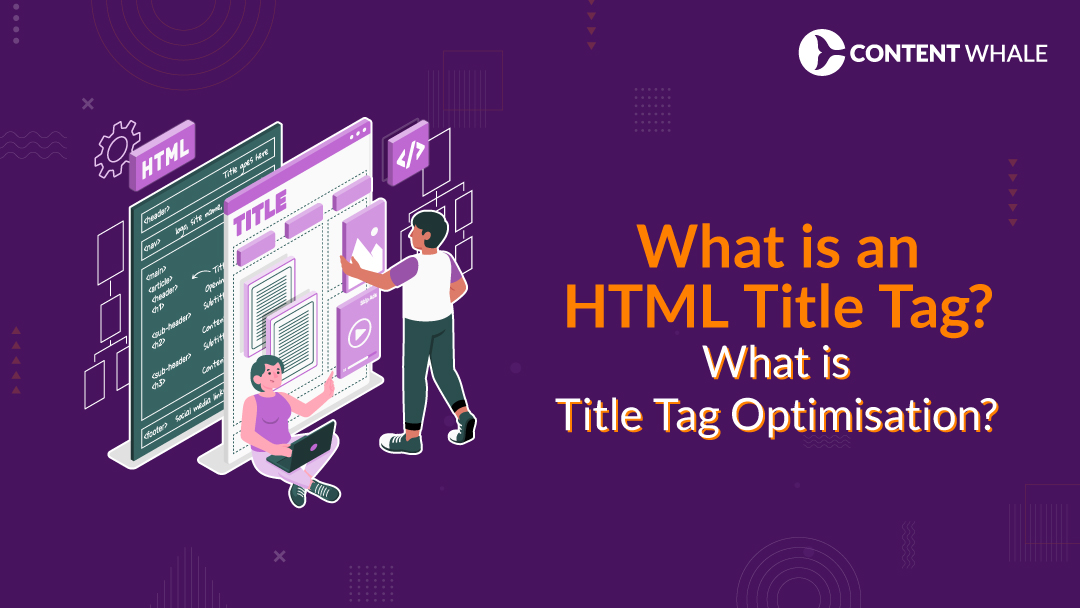HTML title tags are the titles shown in browser tabs and as clickable headlines in search engine results pages (SERPs). These tags are crucial for SEO, influencing how your pages rank and how likely users are to click through to your site. A well-crafted HTML title tag can improve search visibility and user engagement.
Understanding SEO titles helps recognize their impact on search rankings and user experience. Title tags act as the primary page title in SEO, making them essential for drawing attention to your content.
This guide will cover the significance of HTML title tags, title tag optimization techniques, and best practices for crafting effective tags. You’ll find title tag examples and tips for incorporating them into your HTML and various content management systems (CMS). Learn how to define a title tag, understand its use in HTML, and optimize your meta title for better search engine performance.
What is an HTML Title Tag?
An HTML title tag is an element within the head section of an HTML document. It defines the title of a webpage, which appears in browser tabs and search engine results pages (SERPs). This tag provides a brief summary of the page’s content.
The use of a title tag in HTML helps search engines understand the page’s topic and attracts users’ attention in search results. The HTML title tag is different from other meta tags, like the meta title, which can include additional keywords and descriptions.
The HTML title tag appears as clickable text in browser tabs. In SERPs, it shows the main headline for each result, making it essential for both user experience and SEO. Effective title tag optimization can improve your site’s visibility and click-through rates.
Understanding how to define a title tag and its importance is key to SEO. The page title in SEO acts as a direct signal to search engines, helping them rank your content. Knowing the title tag examples and how they function can guide you in creating better titles for your pages.
Importance of Title Tags in SEO
HTML title tags are essential for SEO. They help search engines understand your page content and relevance to search queries. A well-optimized SEO title tag can improve your search engine rankings, making your site more visible to potential visitors.
The meta title directly impacts click-through rates (CTR). A compelling title can attract more clicks, increasing your site’s traffic. Effective title tag optimization ensures your titles are engaging and relevant to users’ search intent.
Title in SEO is critical for user experience. Clear and descriptive titles help users quickly identify if a page matches their search query. This can reduce bounce rates and improve user satisfaction.
Title tag examples from top-ranking pages often include primary keywords and are concise. They reflect the page’s content accurately, making users more likely to click through. By analyzing these examples, you can create effective titles for your pages.
The use of title tags in HTML is straightforward but impactful. Including relevant keywords helps search engines rank your page higher. Regularly updating your page title in SEO can maintain its relevance and effectiveness.
Understanding how to define title tags and their role in SEO can significantly boost your website’s performance. By prioritizing HTML title tags, you enhance your site’s visibility and user engagement, leading to better overall results.
Best Practices for Crafting Effective Title Tags
Creating effective HTML title tags involves several best practices. Keeping titles concise is crucial; aim for 50-60 characters to ensure they display fully in search results.
Include your primary keyword to improve search visibility. For instance, if you target “SEO tips,” your SEO title tag should reflect that. However, avoid keyword stuffing, as it can harm readability and SEO performance.
Use branding effectively. Adding your brand name at the end of the title can enhance recognition. For example, “SEO Tips for Beginners, YourBrand.”
Writing compelling and descriptive titles is essential. A well-crafted title should inform users about the page content and entice them to click. Look at successful title tag examples for inspiration.
Avoid using vague or generic titles. Be specific and clear about what the page offers. This helps both search engines and users understand the page content.
Title tag optimization also involves testing. Conduct A/B tests to see which titles perform better. Use tools like Google Search Console to track performance and make data-driven adjustments.
Ensure each page’s page title is unique in SEO. Duplicate titles can confuse search engines and users, leading to poor SEO results. Each title should accurately reflect the content of its respective page.
The use of a title tag in HTML should follow proper syntax:
- <title>Your Title Here</title>.
Integrating this within the head section of your HTML ensures it’s recognized by search engines.
Understanding how to define title tags and apply these best practices will enhance your site’s SEO. Review and update your meta title regularly to keep it relevant and effective. By mastering these techniques, you can significantly improve your site’s visibility and user engagement.
Title Tag Optimization Tips
Researching and choosing the right keywords is the first step in title tag optimization. Use tools like Google Keyword Planner, Ahrefs, and SEMrush to find relevant keywords. Focus on terms that are popular and relevant to your content.
Plugins and tools can help with SEO title tag analysis. Yoast SEO and All in One SEO are popular plugins for WordPress that provide insights and recommendations for improving your HTML title tag. These tools can help you write better titles and ensure they meet SEO best practices.
A/B testing your meta title can reveal what works best for your audience. Create two versions of a title tag and see which one performs better. Use Google Optimize or similar tools to conduct these tests and gather data on user engagement.
Avoid common mistakes in title tag optimization. Don’t stuff keywords into your titles; keep them natural and readable. Ensure each page title in SEO is unique to avoid confusion and improve clarity for both search engines and users.
The use of title tags in HTML should follow best practices for syntax and placement. Place the <title> tag within the head section of your HTML document. This helps search engines recognize and index your page correctly.
Regularly update your HTML title tags. As your content evolves, your titles should reflect the most current and relevant information. This keeps your titles fresh and aligned with your SEO strategy.
Analyzing title tag examples from top-ranking pages can provide insights into what works well. Look for patterns in their structure, keyword usage, and length. Use these insights to refine your own titles.
By understanding how to define title tags and applying these optimization tips, you can improve your site’s visibility and attract more traffic. Regularly review and adjust your meta title to maintain its effectiveness and relevance.
Examples of Good and Bad Title Tags
Examining title tag examples can help understand what works and what doesn’t. Good HTML title tags are concise, include relevant keywords, and are engaging. For example, “10 Best SEO Tips for 2024” is clear and keyword-rich.
Bad title tags are often vague or too long. An example of a poor meta title would be “Tips for SEO and Other Strategies for 2024 That You Might Find Useful.” It’s too lengthy and not specific enough.
Effective SEO title tag examples often include primary keywords and are straight to the point. For instance, “How to Use Title Tag in HTML for Better SEO” is specific and informative. This kind of title can attract more clicks and improve search rankings.
Common pitfalls in title tag optimization include keyword stuffing and duplication. Avoid titles like “SEO SEO SEO! Tips for SEO Success.” It’s unnatural and can hurt your SEO. Ensure each page title in SEO is unique to its content.
Analyze top-ranking title tag examples in your industry. Notice how they balance keyword use with readability. By avoiding common mistakes and following best practices, you can craft effective HTML title tags that improve visibility and user engagement.
How to Implement Title Tags in HTML
To implement an HTML title tag, place the <title> element within the <head> section of your HTML document. This tag specifies the title of your web page, which appears in the browser tab and search engine results.
Here’s a basic example of the use of a title tag in HTML:
| <head> <title>Effective SEO Tips for 2024</title> </head> |
For content management systems (CMS) like WordPress, plugins like Yoast SEO and All in One SEO can simplify title tag optimization. These tools provide fields for entering your SEO title tag, making it easy to manage your meta title across multiple pages.
Update your HTML title tags regularly to keep them relevant. As your content evolves, your page title in SEO should reflect new keywords and topics. This ensures that your titles stay current and effective.
Understanding how to define title tags and integrate them into your CMS is essential. Different platforms may have specific instructions, but the principle remains the same: the HTML title tag must be accurately placed and relevant to the content.
Following these steps ensures your title in SEO is optimized for search engines and users, enhancing visibility and engagement. Proper implementation of title tag examples can significantly impact your SEO strategy, driving more traffic to your site.
Optimizing your HTML title tag is a powerful way to boost SEO and user engagement. By following best practices and regularly updating your meta title, you can improve your site’s search engine rankings and attract more visitors.
Title tag optimization involves choosing the right keywords, avoiding common pitfalls, and making your titles compelling. Effective SEO title tags and title in SEO contribute significantly to your site’s visibility.
Review and update your page title regularly in SEO to keep it relevant and effective. Analyze successful title tag examples to guide your efforts.
Implementing and maintaining your HTML title tags correctly in your HTML or CMS ensures your titles stay optimized. Understanding how to define title tags and use them effectively is key.
Well-crafted title tags can make a big difference in attracting and retaining visitors. Apply these strategies to enhance your site’s SEO performance and user experience.
What is a title tag in HTML?
An HTML title tag is an element within the head section of an HTML document. It defines the title of a webpage, displayed in browser tabs and search engine results.
How long should a title tag be for SEO?
For effective title tag optimisation, keep your SEO title tag between 50-60 characters. This ensures it is fully displayed in search results without being cut off.
Can I use the same title tag on multiple pages?
No, each page title in SEO should be unique. Duplicate meta titles can confuse search engines and harm your SEO, while unique titles help search engines understand each page’s content.
How often should I update my title tags?
Review and update your HTML title tags regularly to reflect changes in content and keywords. Keeping your title in SEO current ensures ongoing relevance and effectiveness.
What tools can help with title tag optimization?
Tools like Yoast SEO, All in One SEO, Google Keyword Planner, Ahrefs, and SEMrush can assist with title tag optimization. They help you choose the right keywords, analyze your SEO title tags, and provide recommendations.





